Links:
Upcoming
FONT Birding & Nature Tours in Guatemala

Guatemala is a country I've always wanted to visit. There are
mountainous highlands; 33 volcanoes paralleling the Pacific coast 50 to 75
miles inland (three are active); world-renowned Lake Atitlan
(surrounded
by three of those volcanoes); tropical jungles; and abundant
wildlife, with hundreds of bird species, plus spider and howler monkeys,
agoutis, coatis, 4-foot long iguanas, and crocodiles -- that's just what
we were able to see in a short visit. The colonial Spanish capitol of
Antigua is a world heritage site, and there are many extensive
Mayan ruins, the best known being Tikal. And Guatemala has the largest
percentage of indigenous peoples in Central America, direct descendants of
the Mayans whose highly developed civilization collapsed in the 9th
century AD.
There is much to get to know and see in this small Central American
country -- and the gap between photos, and the reality, is astounding.
But we can’t paper over history: a three decade civil war ended in 1996,
after about 200,000 people died (current population is almost 15 million).
While these scars will endure, the sense I had is that the people
understand that tourism -- ecotourism, archeological tourism, adventure
tourism -- will likely be their ticket out of grinding poverty.
My wife, Jan, and I were going to visit Guatemala several years ago,
shortly after the end of the civil war, but a brief episode of violence
caused us to change our minds. So finally, in late December, I took my
first trip to real tropics (heat sickness felled me to unconsciousness in
the Caribbean 35 years ago, or I would have gone earlier). This trip was
technically a birding trip, but it was mostly an adventure with great
birding a constant theme.
I was blown away by pretty much everything -- almost all of it good.
Here's a look at Guatemala through fresh eyes.
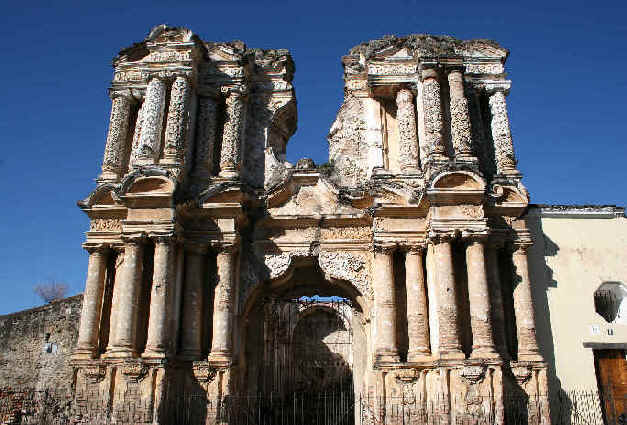
Antigua: an old church
& street scene
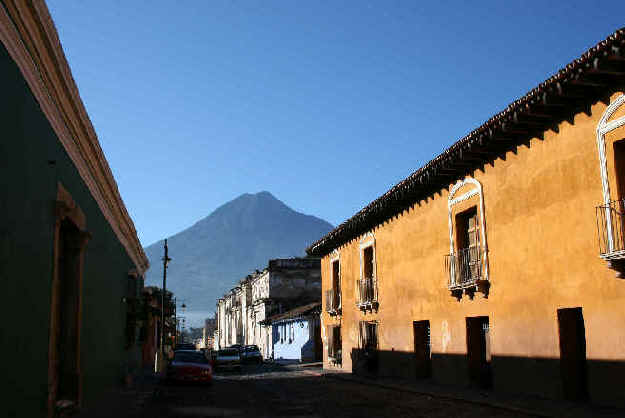
Let the Adventure Begin
Our small group was led by Armas
Hill, founder of Focus On Nature
Tours. He’s a veteran of about three dozen trips to Central America,
about one-third of them in Guatemala. We arrived in Guatemala City in early
evening and took a van to the more charming
Antigua. The rooms of our old
hotel surrounding a courtyard garden open to the sky, festooned with
flowering plants hanging from the second story; much of Antigua’s
intimate beauty is in such places.
We woke to a compact town with streets of well-polished cobblestones, and
with views of three volcanoes. What first strikes you is how nearby and
large they are (about 11,000 to 12,000 feet each), and how perfectly
conical. Three Mount Fujis, absent the snow, but with the added drama of
visible volcanic activity; smoke puffs are visible for 50 miles in any
direction from Volcan Fuego.
At first, I saw Antigua as run down, compared to another exceptional
Spanish colonial city, Oaxaca (in bordering Mexico) -- mainly because
several spectacular old churches lie in ruins, only parts of walls and
columns still standing. They are almost like Greek ruins. Was Guatemala
too poor to rebuild?
Later, I came to understand the portent of the volcanoes. Antigua is far
more earthquake-prone than Oaxaca. A huge 1773 earthquake destroyed the
city, causing the capitol’s relocation to Guatemala City. While some
people stayed behind and rebuilt homes, many churches remained as they
were to this day.
One other aspect of Antigua is that armed soldiers are visible, especially
in the main square. Guatemala's main growth engine is tourism, and the
government is taking no chances.
Near sunset, coming back from birding intact mangrove marshes near the
Pacific Ocean, we looked inland. Afternoon clouds hid most of the land,
but four huge cones breathtakingly rose above them -- a fourth volcano,
further to the south, joined the three near Antigua. Lesser Nighthawks
pivoted effortlessly around our open craft.
The local man with a flat bottom wooden skiff whom Armas had found to be
our guide lived on the river with his family, in a cement structure with a
ceiling and just two walls. We returned after dark, docking into mud, to a
blazing fire, chickens and a naked young child running around. Only once
before have I been this close to such poverty, in rural Nepal. The man was
an excellent guide, subtly changing speed and direction as he followed our
gazes. Saying our goodbyes, we put our hands on each others' shoulders. I
really liked him-- he had great spirit.
In the highlands, many people are walking by the roadside, most carrying
loads, most dressed in the highly colorful, distinctive Guatemalan
clothing found nowhere else. Women have full baskets on their heads, most
not using a hand to balance them. Groups of children wave at our van,
older ones holding infants. I came to understand that they wave in hope
you will stop and give them something -- not begging, but they have very
little up here. The birth rate is high, but the land can't support the
growing population unless they destroy more forests on steeper slopes,
increasing the danger of killer mudslides during hurricanes, such as
occurred with Hurricane Stan in 2005. Ironically, the word
"Guatemala" in a local Mayan dialect means "land of
trees." Thank goodness many still remain.
We stayed that night in San Lucas Toliman on the south shore of
Lake
Atitlan, right under one of three volcanoes surrounding the lake, near a
second volcano we would visit for birding. Our hotel was clean and new but
not luxurious, with rooms echoing the feel of the local structures and
culture; the food was basic but very tasty. Armas had chosen to stay
here rather than in Panajachel, the locality with the best views of the
volcanoes from across the lake, partly because Panajachel is overwhelmed
with tourists -- like Gatlinburg, Tennessee is to Great Smokies National
Park.
A real highlight of birding on Volcan Atitlan was the
White-throated
Magpie Jay, with a body larger than a Blue Jay's, but with two streamer
feathers trailing behind, adding another foot to the bird's length.
Higher up the volcano, we saw a turkey-sized Crested Guan eating fruits on
long limbs. The considerably rarer Horned Guan is in habitat several
thousand feet higher, but we didn’t have access rights on this day.
We were consoled, however, by a soaring Black Hawk-Eagle, a Black-and-White
Hawk-Eagle, and then a pair of Ornate Hawk-Eagles -- that is 3
species of hawk-eagles, all large and rarely seen raptors.
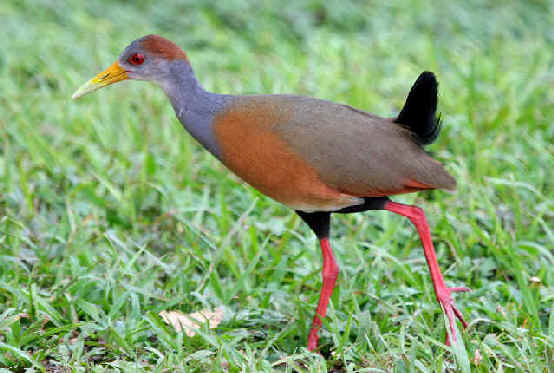
Gray-necked Wood-Rail
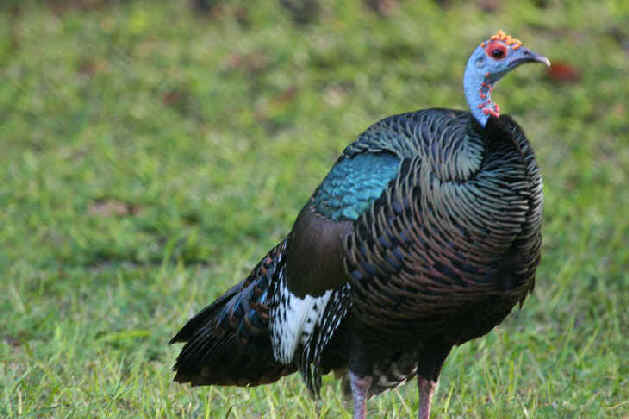
Ocellated Turkey
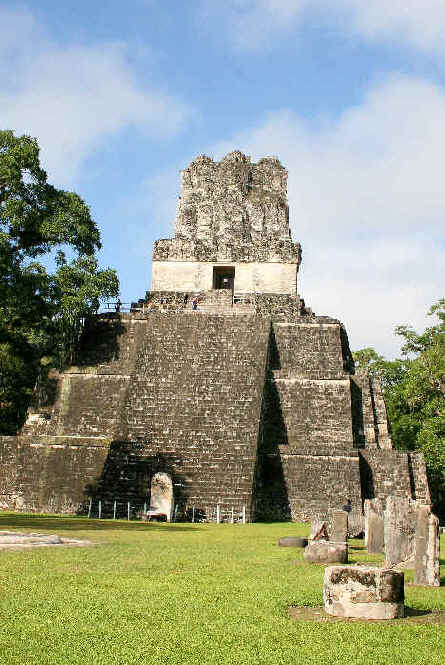
Mayan temple at Tikal
Tikal
After two days of birding around Volcano Atitlan and coffee farm edges,
we returned to Guatemala City for a short New Year's eve flight to the
tropical Peten area. Our New Year's was quiet in tiny
El Remate, on
sixty-mile long, crystal-clear Lake Peten Itza. We stayed at La Casa De
Don David (an American who married a Guatemalan woman and built this
excellent little hotel/restaurant years ago). Nearby was the local nature
preserve we would visit for parts of the next two days.
This area has much lower population density than the highlands, and seems
considerably wealthier. Are tourism dollars per capita higher? More
children are playing -- do children in the highlands have to work more?
Laughing couples ride newish motorcycles -- more smiles all around.
On our first day here, we drove south to a town on the Rio Pasion, renting
a boat and guide. We birded up the river until coming to a landing; 200
wooden stairs higher was the ancient Mayan site, Aguateca. Most of the
large structures were destroyed when Aguateca was sacked, but magnificent
stellae remain. These flat-faced limestone panels are about 15 feet high,
carved with intricate Mayan stylized jaguars, hawks, snakes, and Mayan
rulers in various poses. These exceptionally beautiful stellae were about
1300 years old, but seemed not to have eroded (as have those in Tikal). I
was glad Armas surprised us with this destination -- it was more
magnificent for being unexpected.
The last two days we birded within Tikal itself, staying at the Tikal Inn.
Electricity was on from 6 to 10 in the evening, and for an hour in the
morning. Strangely, this wasn't a hardship -- you could take a hot shower,
but if you took a shower during the day -- humidity close to 100%, it
seemed -- cold was definitely best. At night, with cross-ventilation and
screens, sleeping was comfortable, so no need for AC. And we had pocket
lights for reading after dark.
Tikal (or Tik’al, according to the more current orthography) is the
largest of the ancient ruined cities of the Mayan civilization. According to NOVA (PBS), at its height it covered 25
square miles and might have had 100,000 inhabitants. You can visit seven
temples, numbers 1-6, and 38, which suggests at least 30 temples have yet
to be unearthed. On our full day in Tikal, we walked about 5 miles on the
temple grounds, birding and sightseeing, without visiting the furthest
uncovered site. The wide, well-marked major pathways between the points of
interest are very important, because you do not want to end up lost at the
end of the day in the real jungle which surrounds everything. But Armas
knows the little-used minor paths, better for birding, where we saw many
exquisite birds of Guatemalan jungles.
Soon after entering the park, we spotted a couple of
Keel-billed
Toucans and stopped. A tree with ripe fruit was attracting many
different birds: we had great views of several Collared Aracari (a
small, extremely colorful toucan) and of a lovely Violaceous Trogan
(different shades of purple to teal on the bird, against a canary yellow
breast, and with a large yellow eye ring) willing to pose from many
angles. Black-cowled Oriole, and several more species new to me made
the stop complete. Despite their abundance here, most birds are hard
to observe without a "draw," like a fruiting tree or an ant
swarm. But there are exceptions: the next day, a multi-hued Gray-necked Wood Rail
(brilliant magenta legs bordered by black; a yellow
bill; and a chestnut cap on a gray head) wandered over from the nearby
crocodile pool to grab some potato chips. The Orange-Breasted
Falcon, a striking and much sought-after forest raptor, is seen reliably
only in Tikal; we saw ours high in a tree by the Mundo Perdido
("Lost
World") ruins.
Ocellated Turkeys, easily seen here, have heads covered with bare blue
skin, from which 1/4-inch orange balls irregularly protrude. Crimson
circles each eye. Iridescent feathers -- sparkling different shades of
turquoise, green, magenta, and salmon -- cover the rest: psychedelic
turkey would be more like it!
There is lots of other wildlife in Tikal. Coatis (raccoon-sized, with long
snouts, brown fur, and long, erect tails) rooted for food without concern
for nearby people. A huge crocodile sunned on a tiny island in a small
pond. Quiet, inquisitive spider monkeys gazed at us from 60 feet up.
Active howler monkeys noisily moved around. A large male howler
monkey,
after scaring away a lesser male, broke branches off trees and dropped
them in our direction, then turned his backside to us and defecated!
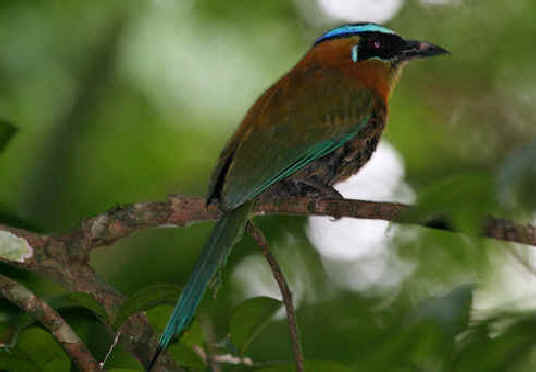
Blue-crowned Motmot
Armas of the Jungle
On our last half day, walking down an overgrown path where a small
airstrip used to be, we ran into an ant swarm, perfect for birding. Thank
goodness they weren’t army ants, which travel in multitudes, are fast,
and bite anything in their way.
People who hadn't been to the tropics -- like me -- have no idea how
important ants are to the ecosystem, as providers of food, directly or
indirectly. Tens of bird species, for example, have names which begin with
"ant" -- ant tanagers, antpittas, antbirds, antthrushes,
antwrens. Now I understand why....
When the ants erupted from the ground, climbing every bush and tree in
large numbers, about 15 species of birds we would normally not see
suddenly appeared. Birds scrambled around to feed, and we jumped around to
follow the action, pinpointing new birds as they arrived. Armas was
transformed from laid-back guide to commander, barking out the names and
directions of birds instant to instant.
Most of the birds seemed to eat ants directly, although some birds prefer
larger insects which the ants drive from the forest litter. One bird
species -- the Tawny-winged Woodcreeper -- specialized in a particular
type of 1 & 1/2 inch spider, which no other bird seemed to have taken.
I would like to spend more time getting to know Guatemala. The people are
eager to help, the food is good, and accommodations are inexpensive. If you find nature and history and archaeology
interesting, this is a great place. Next time I will read up more
extensively before I go, because of the richness of this small but varied
country.


